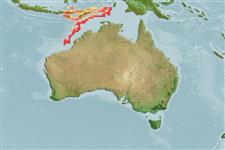Actinopterygii (ray-finned fishes) >
Perciformes (Perch-likes) >
Nemipteridae (Threadfin breams, Whiptail breams)
Etymology: Parascolopsis: Greek, para in the side of + Greek, skolos = stake + Greek, ops = appearance (Ref. 45335); rufomaculatus: Named in reference to the distinctive red spot ('rufus' and 'maculatus') on the dorsal fin.
Environment / Climate / Range
Ecology
Marine; bathydemersal; non-migratory; depth range 210 - 320 m (Ref. 9923). Deep-water, preferred ?; 7°S - 21°S, 119°E - 136°E (Ref. 3810)
Eastern Indian Ocean: known so far only from northwestern Australia.
Size / Weight / Age
Maturity: Lm ? range ? - ? cm
Max length : 15.5 cm SL male/unsexed; (Ref. 3810); common length : 10.0 cm SL male/unsexed; (Ref. 3810)
Dorsal
spines
(total): 10;
Dorsal
soft rays
(total): 9;
Anal
spines: 3;
Anal
soft rays: 7. Head scales reaching forward to between middle of eyes. Posterior margin of preopercle sloping forward slightly. Lower limb of preopercle naked. Posterior margin of suborbital finely denticulate. Pectoral fins moderately long, reaching to or just short of level of anus. Pelvic fins short, not reaching to level of anus. Axillary scale present. Color: Pinkish body, pearly-white below.
Occurs in offshore waters. Feeds mainly on benthic invertebrates. Taken by bottom trawls (scampi nets).
Life cycle and mating behavior
Maturity | Reproduction | Spawning | Eggs | Fecundity | Larvae
Russell, B.C., 1986. Two new species of Parascolopsis (Piseces: Nemipteridae) from North-western Australia, Indonesia and the Philippines. Beagle, Occas. Pap. North. Territ. Mus. Arts Sci. 3(1):137-142. (Ref. 9923)
IUCN Red List Status (Ref. 115185)
CITES (Ref. 94142)
Not Evaluated
Threat to humans
Harmless
Human uses
Fisheries: subsistence fisheries
More information
Common namesSynonymsMetabolismPredatorsEcotoxicologyReproductionMaturitySpawningFecundityEggsEgg development
ReferencesAquacultureAquaculture profileStrainsGeneticsAllele frequenciesHeritabilityDiseasesProcessingMass conversion
Tools
Special reports
Download XML
Internet sources
Estimates of some properties based on models
Phylogenetic diversity index (Ref.
82805): PD
50 = 0.5002 [Uniqueness, from 0.5 = low to 2.0 = high].
Bayesian length-weight: a=0.01445 (0.00690 - 0.03030), b=2.98 (2.80 - 3.16), in cm Total Length, based on LWR estimates for this (Sub)family-body shape (Ref.
93245).
Trophic Level (Ref.
69278): 3.5 ±0.37 se; Based on food items.
Resilience (Ref.
69278): Medium, minimum population doubling time 1.4 - 4.4 years (Assuming tmax>3).
Vulnerability (Ref.
59153): Low vulnerability (20 of 100) .
